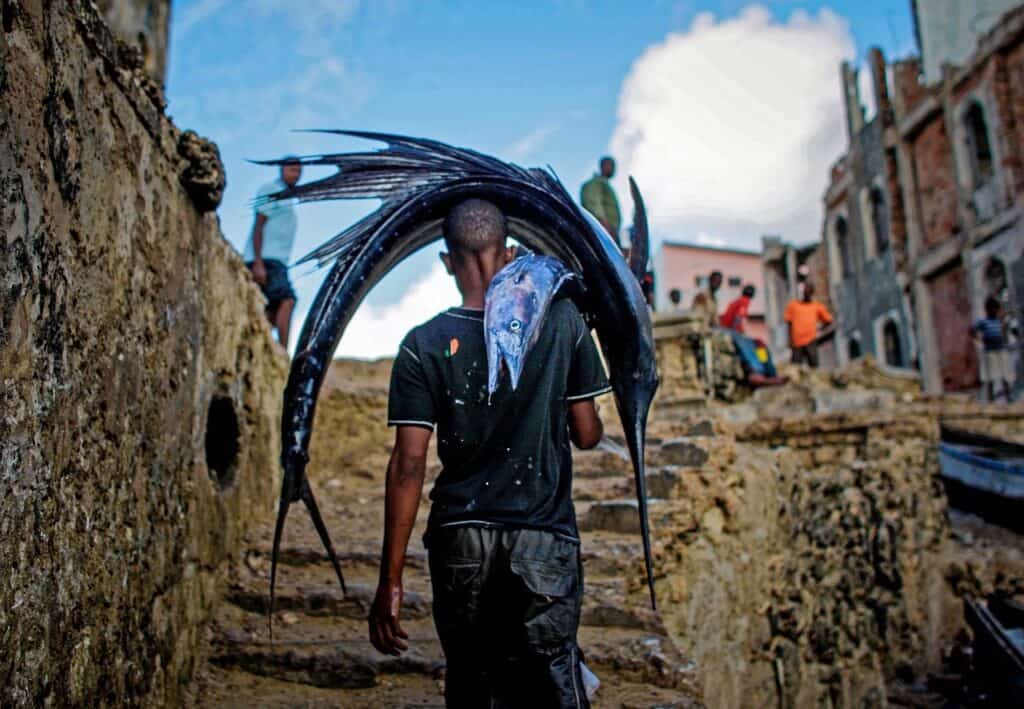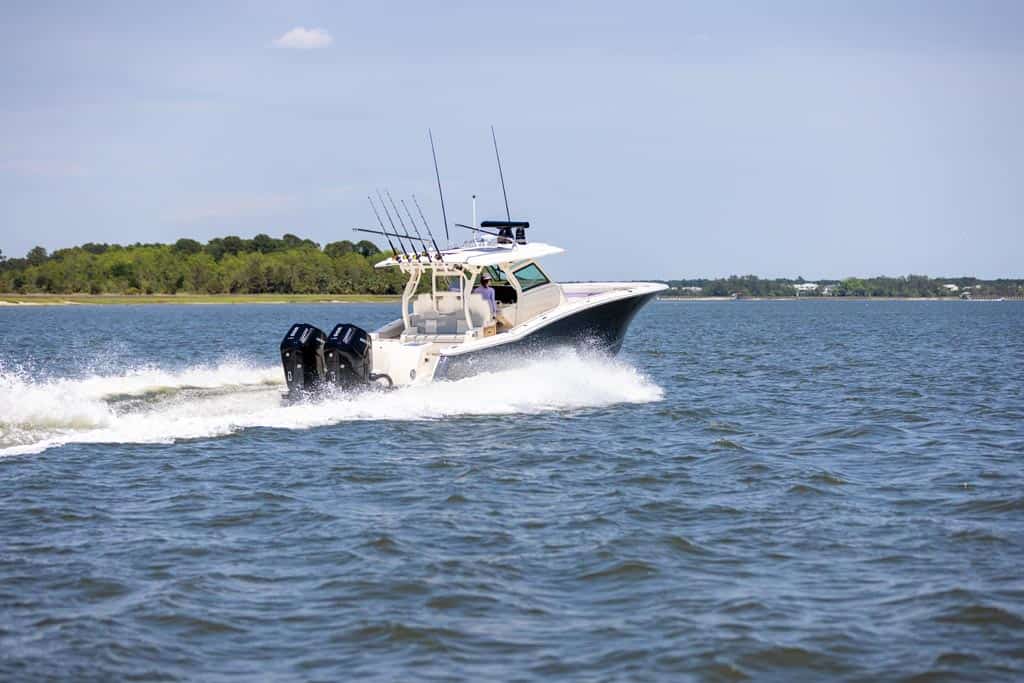
Not many fish can give you the same adrenaline rush as an acrobatic Sailfish flashing all its sensational flair and fight at the end of your rod.
And this offshore sport fishing favorite is not restricted to traditional rod and reel equipment.
Fly fishing anglers love catching sailfish too! Here’s a peek into how to get an Indo-Pacific sailfish on the fly.
All About the Indo-Pacific Sailfish
The Indo-Pacific Sailfish, scientifically named Istiophorus platypterus, and its sister fish, the Atlantic sailfish, or Istiophorus albicans, are what anglers often refer to as billfish. Like Marlin, they have an extremely pronounced upper jaw that creates a sword-like appendage.
They use their sword to whip up bait balls, stunning fish, making them easier to catch as dazed fish slowly sink to the bottom. Sailfish don’t actually spear their prey. However, they have speared more than one fisherman!
But their most distinctive visual characteristic is their sail. It’s actually their first dorsal fin, and it runs almost the entire length of their body and is many times higher than their body height. (The massiveness of the sail has led to many anglers overestimating the size of their catch.)
It’s a dramatic look, to say the least.
No wonder they are among the most popular subjects on fishing-related shirts, murals, mugs, and coastal art.
To keep the drama coming, they are spectacularly colored, from dark, inky blues to metallic silvers that are often bedazzled with iridescent sky-blue dots. Even more, the sailfish is able to change colors—often flashing boldly to distract prey or signal to other fish.
“They are the peacock of the sea with glorious colors and a graceful winged shape,” says Donnell Tate of Hawaii.
Besides being spectacular looking, they’re big. Sometimes over 200 pounds, big! The Indo-Pacific sailfish is larger, averaging 80-120lbs. Whereas the Atlantic sailfish averages 60-100lbs. The Indo-Pacific sailfish has also been noted as being more aggressive and less skeptical of bait.
Both species are crazy fast. One of the fastest fish in the sea, in fact. They can reach speeds up to 68 mph.
Fly Fishing for Sailfish
Sailfish have long been a sport fishing favorite. They provide an unmatched acrobatic show, breathtaking appearance, and fight with an admirable amount of resolution.
Most commonly, they are sought by offshore, deep-sea anglers. And are often caught by fishermen targeting other pelagic species like Mahi-Mahi or tuna.
Due to their concentrations in some waters, it is even possible to catch several in one day.
But, surprising to many, they are also a prize target for fly fishing anglers. With their size and reputation for speed and fight, it seems unlikely that catching an Atlantic or Indopacific sailfish on a fly would be possible, but it is quite doable.
Few game fish are as majestic and offer the kind of challenge sailfish pose to fly anglers. Although fast, powerful and very acrobatic, with some teamwork and the right technique, this popular big game species can be fooled and tamed with fly-fishing gear.
—Alex Suescun
Where to Find the Atlantic & Indo-Pacific Sailfish
Between the two sailfish species, the Atlantic and Indo-Pacific sailfish, they can be found across the globe in warm, tropical waters. From Massachusets to Madagascar, India to Australia. In the colder climates, sailfish will be seasonal as they migrate to warmer waters and their preferred food sources.
The Indo-Pacific sailfish are particularly abundant off Papua New Guinea, the Marquesas, and Hawaii.
The Atlantic sailfish populations are most dense in Southern Florida, Mexico, and Central America. The Sailfish is Florida’s state saltwater fish. But they can be found along the entire eastern U.S. seaboard. And, since they often swim in shallow waters, they are very attainable for most anglers in coastal boats. But sailfish have even been caught from ocean piers!
Tips for Catching Indo-Pacific Sailfish on a Fly

Sailfish respond like wahoo or dogtooth tuna. They can be “teased up” from deeper waters by exciting the surface. Once their attention has been garnered, treat them to one of your largest flies.
Understanding their natural feeding preferences can help.
Though inhabiting all deep oceanic waters, sailfish are frequently found near the shore. Sailfish will work small bait balls into shallower waters. This is often observed in the clear, shallow waters of the Florida Keys. Sometimes they are even fished “by sight.”
They prey on ballyhoo, flying fish, sardines, anchovies, jacks, and also cephalopods, including squid and even octopus.
They are often found around reefs, wrecks, and other structured bottoms where there is an increase in marine life and food options.
Packing the Tacklebox
Both the Atlantic and Indo-Pacific sailfish will require the same fly rods and flies.
Reach for a heavier rod, 11-12 wt. But the reel selection is most important. It needs to be strong, smooth, and capable of a large quantity of line. Sailfish are known to run hundreds of yards.
You can buy a line specifically for billfish. It will float yet allow your fly to sink under enough to create the live-action desired.
For flies, the most common setup is using a popper head just above your larger fly choice with two hooks—one pointed in each direction.
While you’ll be handling your equipment, the process is a team effort that likely includes the captain and someone managing the teasers. A line of teasers (often pink squids with no hooks) will be trolled behind the boat to attract attention.
Once the sailfish arrives on the scene, the hookless teasers are pulled up, and the captain navigates the boat into casting range; all the while, a second person is keeping the attention and building the appetite of the sailfish with a ballyhoo or other similar hookless bait. Once the sailfish is in casting range, it too is pulled up, leaving the fish with one option left: your fly.
Once your fly does the job, be ready for a show beyond any high-flying circus act. You are in for a dazzling performance of jumps, flips, head thrashing, and fast jogs.
Now all you have to do is keep the slack out of the line. You know, that’s all.
But this is why sailfish provide a catch that never grows old, no matter how many you’ve caught. Keep your rod low and work your drag deliberately to increase your chances of getting your beauty to the boat.
Best Practices for Releasing Sailfish
More and more charter captains are restricting the practice of hauling aboard Sailfish for camera-shoot opportunities as the release survival rate is poorer than previously believed among sailfish that have had a prolonged fight and out-of-water experience.
In addition, their sails are very delicate and covered with a thin protective slime that is easily damaged when being hauled over the side and across the deck.
The best practice is to leave the fish in the water after the catch and allow them to recover from the traumatizing fight by slowly trolling them at the surface, allowing them to regain their strength so they are not at risk from predators and can resume healthy feeding. This may take a full five minutes.
Newsworthy Notes About the Indo-Pacific Sailfish
Sailfish are prolific fish that have a relatively short life span, an average of four years. This is beneficial for their population. While neither the Atlantic Sailfish nor the Indo-Pacific Sailfish is sought after as a commercial food fish, they do feel the impact of both sportfishing and commercial fishing.
As mentioned above, without careful handling, the sailfish’s survival rate can be low upon release.
But more harmful to the populations is their incidental catch numbers in commercial trawling vessels fishing for tuna. The Indo-Pacific sailfish is either dumped, dead, back in the sea when caught in the huge nets or sold for a minimal price for filler and feed.
In 2021 the Sailfish was added to the IUCN Red List of Threatened Species and labeled as “vulnerable,” a change from the previous listing of “least concern.”
Because of the threat of overfishing, “all U.S. flagged commercial vessels are prohibited from selling, retaining, or purchasing Atlantic billfish, including sailfish.
Additionally, recreational fishers must obtain a permit from NOAA fisheries for fishing in federal waters, and state regulations may also apply.
The minimum size limit for sailfish of 63 inches (160 cm) lower jaw fork length applies shoreward of the outer boundary of the U.S. Exclusive Economic Zone.” (source)
Therefore, it is critical to know the changing regulations for where you are regarding sailfish.
Fishing with Scout Boats

Whether going for a sailfish on a fly or with traditional tackle, it’s an experience that will be imprinted in your memory. An experience most often shared with friends or family around you.
Scout Boats knows how these experiences create life-long memories and bonding moments that are hard to recreate on land. Our fleet of boats provides a range of models designed with the most advanced technologies in the boat-building industry, superior manufacturing processes, and the most luxurious finishes.
You can peruse our models here. There are plenty that will get you offshore and hooking a sailfish of your own!

